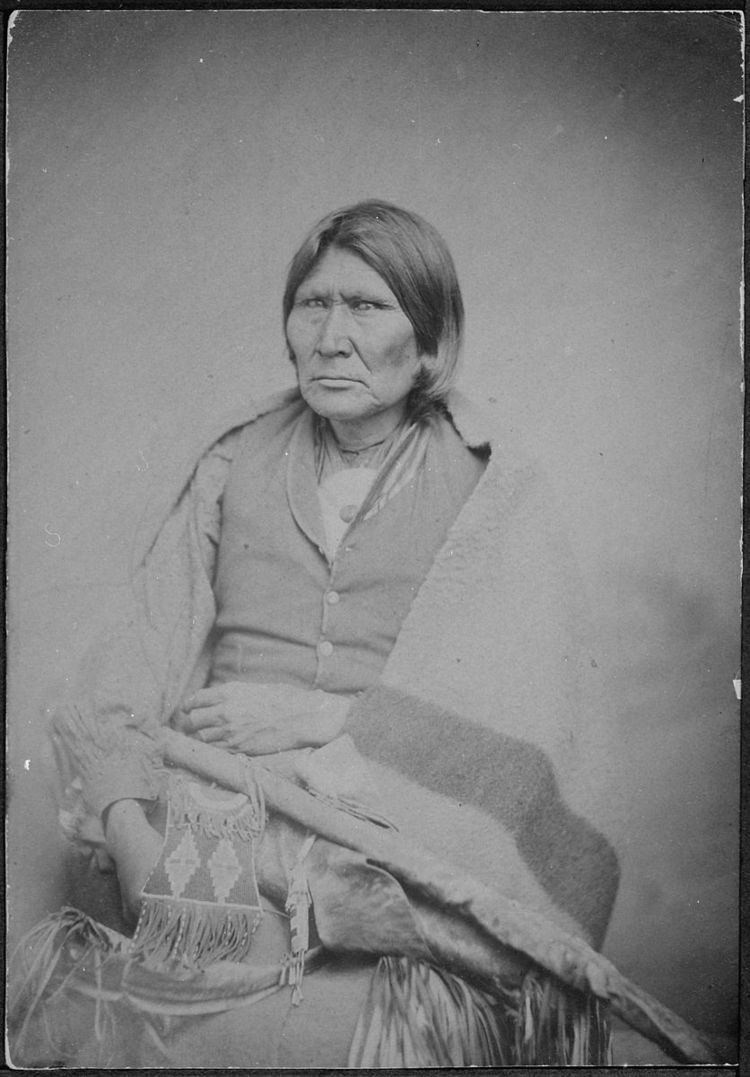Children Name Horseback Horseback | Role Chief | |
 | ||
Known for 1850–1870 as a peaceful chief, led the Nokoni Comanche tribe during the last decade of the "Indian wars" Died 1888, Anadarko, Oklahoma, United States | ||
Comanche horseback ride 4
Horseback (Comanche, Tʉhʉya Kwahipʉ "horse back") was a Nokoni Comanche chief.
Contents
- Comanche horseback ride 4
- Young man warrior and war chief
- Diplomat and peaceful leader
- Attack on Horsebacks village in the Antelope Hills
- The last fight for freedom
- The sunset years
- References
Young man: warrior and war chief
In his prime, he made his career under the elder Huupi-pahati ("Tall Tree"), head chief of the Nokoni band, and Quenah-evah ("Eagle Drink"), second chief and later successor to Huupi-pahati himself possibly after the smallpox and cholera epidemics occurred in 1849; during the 1840s and 1850s he gained a good fame as a war leader against Comanche’s Indian enemies and a raider through Texas.
Diplomat and peaceful leader
In 1861, along with the Yamparika head chief Ten Bears and the Penateka chiefs Tosahwi ("White Knife") and Asa-havey ("Milky Way"), went to Fort Cobb where they met C.S.A. gen. Albert Pike, and the Comanche chiefs (including Quena-evah) signed for an allegiance with the Confederation. He became head chief of the Nokoni after Quena-evah's death, possibly in 1866. Not a long time after Peta Nocona's death about 1864, and having become the new first chief of the Kwahadi Comanche, Horseback took with him the two adolescent sons of the dead Kwahadi chief, Quanah Parker and Pecos, to complete their training as young men and warriors.
Horseback signed for the Nokoni the Medicine Lodge Treaty (Oct. 21 1867), emerging as the leader of the "peaceful" faction of the band, but the second-ranking chief, Big Red Meat, took the leadership of the uncompromising faction, and on the same "hostile" line was Tahka ("Arrowpoint"), war chief of Horseback's own party.
On Dec. 12, 1868, while Horseback was not in his village in the spot after known as Soldier Spring, this one became the theater of a big fight against 3rd Cavalry and 37th Infantry U.S. troops; the soldiers came on the village and the war chief Tahka reacted against the "long knives" leading the Nokoni warriors to fight; the Nokoni were defeated, Tahka being killed in the battle, and the village was burnt and stocks destroyed.
Attack on Horseback's village in the Antelope Hills
On December 19, 1868 a large Comanche and Kiowa band faced a company of 10th Cavalry (maj. M.H. Kidd) on the way from Fort Arbuckle to Fort Cobb. On December 25, six companies of the 6th Cavalry and one company of 37 Infantry (maj. A.W. Evans), on the way from Fort Bascom (New Mexico) to the Antelope Hills, came on the Nokoni village (about 60 tipis) of Horseback and Arrowpoint, where Yamparika chief Howea was as a visitor; Horseback, the peaceful civil chief, was not in the camp, and Arrowpoint’s blood was still boiling after the Washita massacre. Seeing the soldiers arriving, and being taunted by the Kiowa allies, Arrowpoint, the war chief, led the Comanche warriors in a charge, but he was killed and the village and the stocks went destroyed. Kiowa warriors led by Manyi-ten came to take part in the fight; only one soldiers was killed. In December 1868, exhausted after lack of food and freezing weather, the Nokoni went to Fort Cobb and there surrendered.
The last fight for freedom
Like Tosawi, Horseback managed to keep out the Nokoni preventing their involvement in the Red River War in 1873–1874, but only a faction of Nokoni band followed him along the "peace road", while Piaru-ekaruhkapu joined the hostile Comanche and Kiowa faction, uniting himself and his Nokoni warriors to Quanah Parker, Bull Bear, Kobay-oburra ("Wild Horse"), Kobay-otoho ("Black Horse"), Isatai'i, and their Quahadi Comanche, to Mow-way and his Kotsoteka, to Tabananika ("Sound-of-the-Sunrise"), Isa-rosa ("White Wolf") and Hitetetsi aka Tuwikaa-tiesuat ("Little Crow"), son to Ten Bears, and their Yamparika, and to the Kiowa led by Guipago, Satanta, Zepko-ete ("Big Bow"), Tsen-tainte ("White Horse") and Mamanti ("He Walking-above").
The sunset years
After the Palo Duro campaign (1874) and the surrendering of the last hostile Comanche groups coming back from the Staked Plains, he was appointed by the Army as head chief of all the Comanches, and was ordered to pick out the "worst" Comanche, to send them to Fort Marion, Florida; the same happened to Tene-angopte for the Kiowas, and the Kiowa chief pointed out 27 chiefs and warriors, but Horseback was able to sacrifice only nine men (one Black Horse, but probably not Kobay-otoho third chief of the Quahadi band, and eight "outlawed" warriors), preventing the deportation of all the defeated chiefs (but, unfortunately, not the life of Parra-ocoom, dead on June 27–28, 1874, during the Adobe Walls fighting, and that of Piaru-ekaruhkapu, dead in the icehouse – temporarily used as a jail – of Fort Sill on January 1, 1875. Together with Quanah and some of the old chiefs, Horseback was a constant point of reference for the Comanche people in the reservation until his death in 1888.
